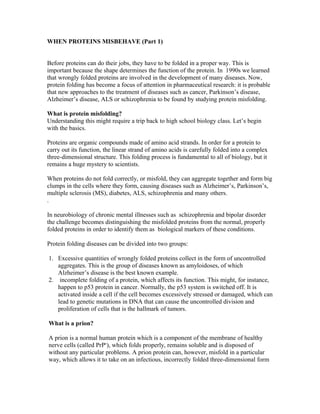
When proteins misbehave (part 1)
- 1. WHEN PROTEINS MISBEHAVE (Part 1) Before proteins can do their jobs, they have to be folded in a proper way. This is important because the shape determines the function of the protein. In 1990s we learned that wrongly folded proteins are involved in the development of many diseases. Now, protein folding has become a focus of attention in pharmaceutical research: it is probable that new approaches to the treatment of diseases such as cancer, Parkinson’s disease, Alzheimer’s disease, ALS or schizophrenia to be found by studying protein misfolding. What is protein misfolding? Understanding this might require a trip back to high school biology class. Let’s begin with the basics. Proteins are organic compounds made of amino acid strands. In order for a protein to carry out its function, the linear strand of amino acids is carefully folded into a complex three-dimensional structure. This folding process is fundamental to all of biology, but it remains a huge mystery to scientists. When proteins do not fold correctly, or misfold, they can aggregate together and form big clumps in the cells where they form, causing diseases such as Alzheimer’s, Parkinson’s, multiple sclerosis (MS), diabetes, ALS, schizophrenia and many others. . In neurobiology of chronic mental illnesses such as schizophrenia and bipolar disorder the challenge becomes distinguishing the misfolded proteins from the normal, properly folded proteins in order to identify them as biological markers of these conditions. Protein folding diseases can be divided into two groups: 1. Excessive quantities of wrongly folded proteins collect in the form of uncontrolled aggregates. This is the group of diseases known as amyloidoses, of which Alzheimer’s disease is the best known example. 2. incomplete folding of a protein, which affects its function. This might, for instance, happen to p53 protein in cancer. Normally, the p53 system is switched off. It is activated inside a cell if the cell becomes excessively stressed or damaged, which can lead to genetic mutations in DNA that can cause the uncontrolled division and proliferation of cells that is the hallmark of tumors. What is a prion? A prion is a normal human protein which is a component of the membrane of healthy nerve cells (called PrPc ), which folds properly, remains soluble and is disposed of without any particular problems. A prion protein can, however, misfold in a particular way, which allows it to take on an infectious, incorrectly folded three-dimensional form
- 2. (called PrPsc ). The infectious prion, which can be transmitted in the diet, triggers a domino effect in healthy prions, forcing them to adopt its incorrectly folded form. Protein misfolding in schizophrenia A recently published study by Verian Bader, Philipp Ottis, Martin Pum, Joseph P. Huston, Carsten Korth from the Department of Neuropathology, Medical School Düsseldorf, Germany, Center of Behavioral Neuroscience, University of Düsseldorf identified a misfolded protein, called collapsin-response mediator protein 1 (CRMP1) as a marker for schizophrenia. Crimp1 is a protein expressed by the DISC1 gene involved in schizophrenia. http://hmg.oxfordjournals.org/content/early/2012/08/07/hmg.dds273.abstract also: http://www.jove.com/video/4132/generation-purification-characterization-cell-invasive- disc1-protein ADONIS SFERA, MD
